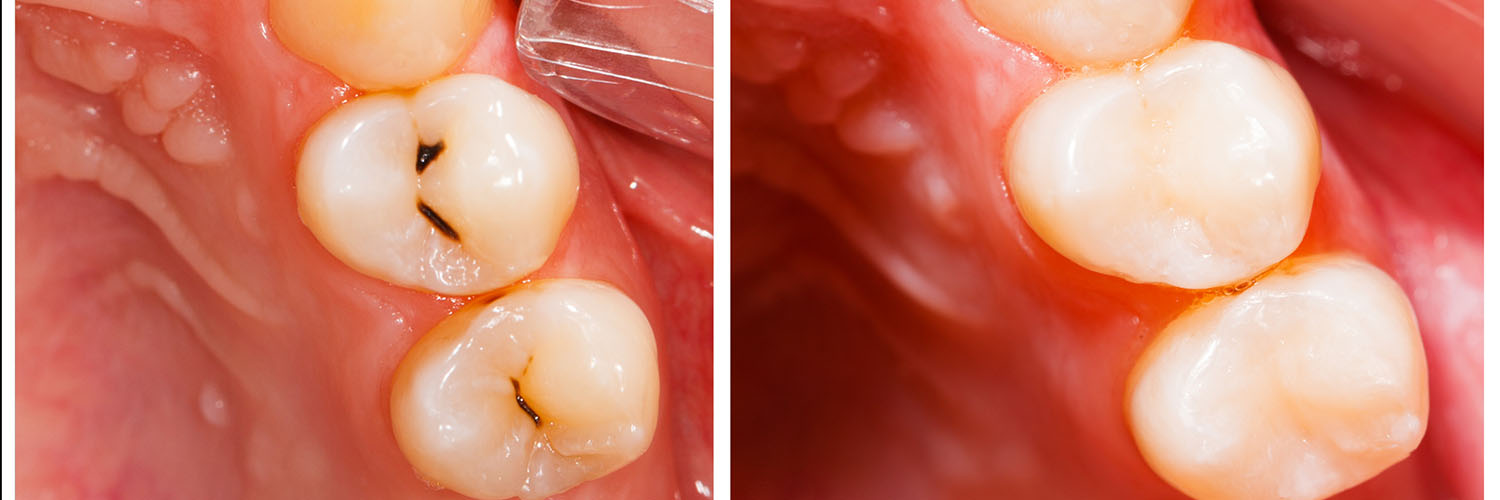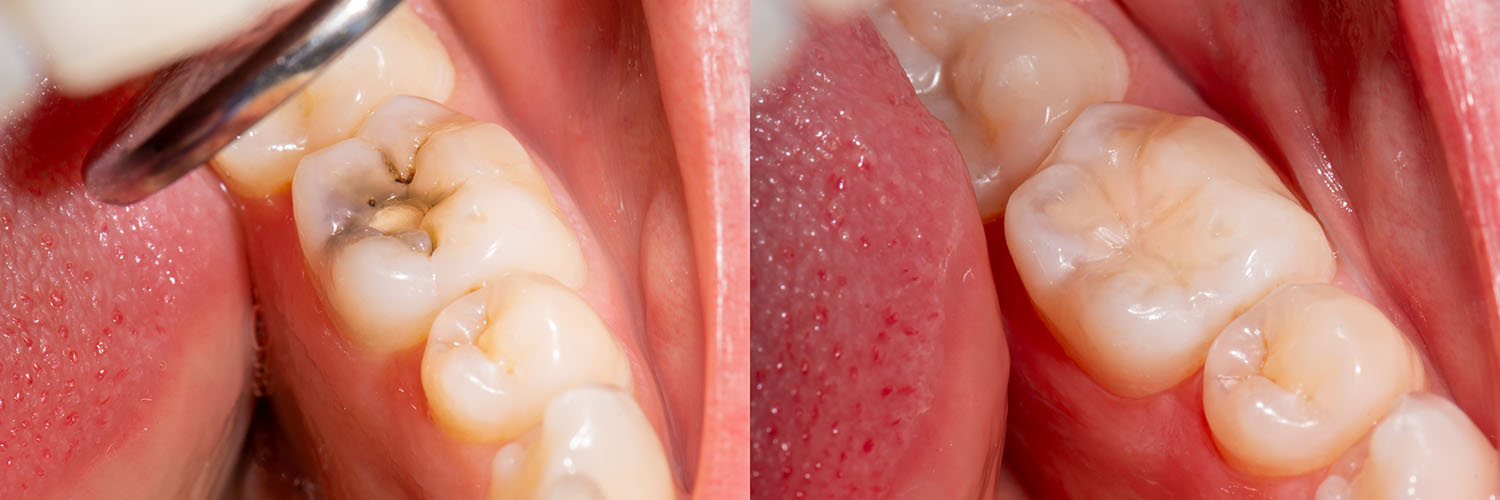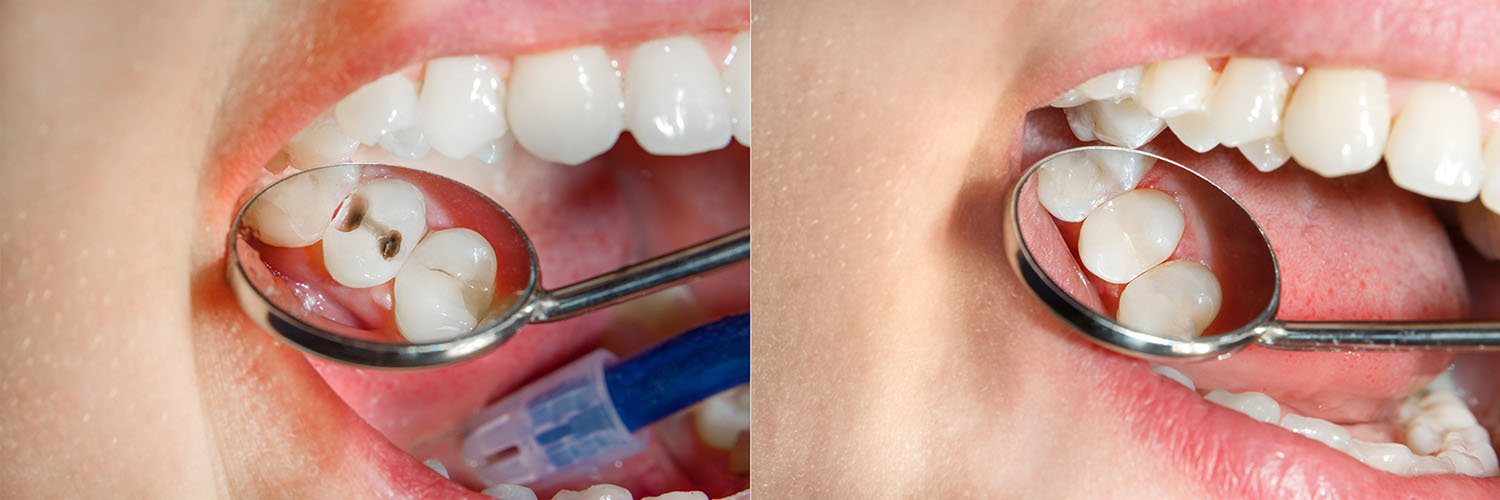
When a cavity or other damage compromises a tooth, a filling is often the simplest and most effective way to repair form and function. Fillings replace lost tooth structure, seal the area against further decay, and restore the surface you use for chewing and speaking. The goal is to preserve as much natural tooth as possible while returning the tooth to a healthy, usable state.
Advances in dental materials and techniques mean today’s restorations are stronger, more comfortable, and more natural-looking than ever. Whether the concern is a small spot of decay or a larger area of breakdown, the right filling material helps the tooth withstand daily forces without drawing attention to the repair.
Every filling procedure starts with a precise diagnosis and a treatment plan that considers tooth location, the extent of damage, and cosmetic goals. These decisions guide material selection and technique so the finished restoration blends with the surrounding teeth and supports long-term oral health.
Fixing teeth is one of dentistry’s oldest goals. Archaeological evidence shows people attempted primitive repairs thousands of years ago, but modern restorative dentistry took shape only in the past two centuries. Metal alloys, particularly amalgam, were widely used because they were robust and easy to place, establishing a practical standard for many decades.
Over recent decades, however, research and innovation produced a wider palette of options. Materials such as tooth-colored composite resins, glass ionomer cements, and ceramic inlays now emphasize conservation, appearance, and biocompatibility. These newer options give clinicians greater control over both strength and esthetics.
Today, material choice reflects what matters most to each patient: durability, visual harmony with adjacent teeth, or specific functional needs. By understanding how each material behaves over time, clinicians can recommend restorations that match a patient’s lifestyle and the technical demands of the tooth.
Our approach centers on preserving healthy tooth structure and addressing the underlying causes of decay. We evaluate not just the visible cavity, but the bite, adjacent teeth, and your oral hygiene habits to create a treatment plan that supports long-term success. The emphasis is on minimally invasive dentistry: removing only what is necessary and rebuilding what is lost.
Patient comfort and clear communication are key elements of care. We explain the steps of the procedure, the reasons for selecting a particular material, and what you can expect immediately afterward. If you have concerns about sensitivity, aesthetics, or the procedure itself, we address them up front so you feel informed and confident.
When appropriate, we incorporate modern tools—such as magnification, conservative tooth preparation techniques, and high-quality adhesive systems—to strengthen the bond between the filling and the tooth. This combination of skill and technology aims to deliver predictable results that protect your natural smile.

Not every filling material performs the same way in every situation. Choice depends on the tooth’s location, how much structure remains, aesthetic priorities, and long-term expectations. For instance, a front tooth restoration emphasizes appearance, while a back tooth requires materials that tolerate strong chewing forces.
We discuss the advantages and limitations of available options and recommend solutions that balance strength, longevity, and visual harmony. When possible, we favor conservative techniques that allow for easy repair or replacement in the future rather than more aggressive treatments that remove healthy tissue.
Material science continues to evolve, giving clinicians improved adhesives, more wear-resistant composites, and ceramics that closely mimic natural enamel. Using these tools thoughtfully helps avoid unnecessary removal of tooth structure while delivering restorations that function well for years.
Composite resins are made of a blend of resin and finely ground filler particles and can be shaded to match your natural teeth. They are bonded directly to the tooth and often require less removal of sound structure than traditional metals. This adhesive approach can strengthen weakened areas and provides an excellent aesthetic result for visible teeth.
Composites are versatile and used for small-to-moderate restorations, cosmetic bonding, and minor shape corrections. They may show wear or discoloration over many years, but modern formulations resist staining and offer substantial durability when properly maintained.
Amalgam fillings have a long track record for durability in high-load areas such as molars. They are less technique-sensitive during placement and can tolerate heavy chewing forces. While less aesthetic than tooth-colored materials, they remain a practical option when strength and longevity are the primary concerns.
Glass ionomers bond to tooth structure and release fluoride, offering a protective benefit in areas at higher risk for decay. They are often used in pediatric restorations, for small cavities near the gumline, or as temporary restorations. Their wear resistance is lower than composites and ceramics, so they are selected when adhesion and fluoride release are priorities.
Ceramic and porcelain restorations are fabricated outside the mouth and then bonded into place. They provide exceptional wear resistance, color stability, and a lifelike appearance. Indirect restorations are an excellent choice for larger defects when a direct filling would not sufficiently restore strength or when superior aesthetics are desired.
Gold remains a high-performance restorative material because of its strength, longevity, and gentle interaction with the opposing teeth. While less common today due to cost and esthetic preferences, gold inlays and onlays are well suited to patients seeking durable, long-lasting restorations in non-front teeth.

A typical filling visit begins with a thorough exam and any necessary imaging to confirm the extent of the decay. Once the treatment plan is agreed upon, the tooth is isolated and the area is numbed so you remain comfortable throughout the procedure. We take care to explain each step and to answer questions before beginning.
Decay is then removed using techniques appropriate to the case—traditional rotary instruments, air abrasion, or laser devices—depending on the location and extent of the lesion. The goal is to eliminate diseased tissue while conserving sound tooth structure so the restoration has the strongest possible foundation.
After preparing the tooth, we place the chosen material using methods that optimize bond strength and fit. Direct materials like composites are shaped and cured in-office, while indirect restorations such as ceramic inlays may require fabrication in a lab and a second appointment for cementation. Finally, the bite is checked and adjusted so the restored tooth functions comfortably.
If dental anxiety is a concern, please mention it during your consultation. We offer strategies to promote relaxation and comfort so your visit is predictable and as stress-free as possible.
After receiving a filling, most patients return to normal activity the same day. It’s normal for a newly restored tooth to feel slightly different until your jaw and bite settle. Any lingering numbness from the anesthetic will wear off within a few hours—exercise caution while eating or drinking until normal sensation returns.
Short-term sensitivity to hot or cold is common and usually resolves within days to weeks. If sensitivity persists or you develop pain that does not respond to over-the-counter measures, contact our office so we can assess the restoration and the surrounding tooth.
Long-term care of fillings relies on consistent oral hygiene and regular dental visits. Brush twice daily with a fluoride toothpaste, floss daily, and keep routine checkups so we can monitor restorations for wear, marginal breakdown, or secondary decay. Early detection of small issues helps avoid more extensive work later on.
Protect the area while numb
Until normal feeling returns, avoid chewing on the treated side and be mindful of hot drinks to prevent accidental bites or burns.
Expect slight bite adjustments
Occasionally, a minor smoothing or adjustment is needed after placement. If your bite feels high or uncomfortable, let us know so we can refine the restoration.
Watch for prolonged sensitivity or discomfort
Transient sensitivity is normal, but ongoing pain, swelling, or discoloration merits evaluation to rule out underlying issues.
Maintain good oral hygiene
With proper brushing, flossing, and regular dental check-ups, most modern fillings serve well for many years. If a filling becomes worn or compromised, early replacement lowers the risk of further damage.
We aim to provide restorative care that combines durability with natural aesthetics. If you have questions about which filling option is best for your situation, or about the placement process, our team is ready to help.

Dental fillings are a practical, conservative way to restore damaged teeth and protect them against further decay. Modern techniques and materials allow restorations that are strong, discreet, and tailored to each patient’s needs. Choosing the right option depends on the tooth involved, functional demands, and personal preferences.
If you would like to learn more about options for repairing a cavity or replacing an old filling, the team at M. Kurt Berky, DDS, PC can help you evaluate what will work best for your smile. We focus on clear explanations and treatment plans that aim to preserve your natural teeth and keep you comfortable throughout the process.
To discuss your situation in more detail or to schedule an evaluation, please contact us for more information. We’re happy to answer your questions and guide you toward durable, attractive restorative care.

If the pleasure of eating a delicious bowl of ice cream or sipping a soothing cup of tea gets overshadowed by dental pain that makes you wince; it's time to contact our office. As skilled providers of care, we'll determine what's causing your discomfort and perform the treatment required to alleviate your symptoms and get you back on the road to oral health.
Cavities develop because of an infectious process that causes progressive damage to tooth structure. Despite starting as a pinpoint defect on the outermost enamel layer of your tooth, untreated dental decay progressively compromises more and more healthy tooth structure as it works its way to the inner layers of your tooth.
Yes, you can still develop tooth decay on other surfaces of the tooth, around the margins of an old filling, or in fewer instances, recurrent decay underneath it. For this reason, it's essential to maintain excellent oral hygiene, a diet low in sugary beverages and sweets, and be sure to visit our office for routine checkups and care. While tooth decay is second only to the common cold in frequency, it's almost entirely preventable.
We value the time and comfort of our patients. If cavities are located on adjacent teeth, or in the same section of your smile, it may be possible to treat more than one tooth during your visit. However, how much is done each visit depends on several factors. We keep our patients well informed and tailor every treatment plan and visit to address their unique needs.
Addressing concerns on the presence of elemental mercury in silver fillings, the American Dental Association (ADA), The Center for Disease Control and Prevention (CDC), the FDA, and the World Health Organization have all stated that amalgam restorations do not pose a risk to health. However, individuals with allergies or sensitivities to the metals in dental amalgam are advised to pursue other restorative options.
Dental fillings are performed under local anesthesia to help ensure your comfort throughout the entire procedure. The involved tooth remains completely numb for the extent of your visit. Within one or two hours after the procedure is completed, the local anesthetic will gradually wear off, and normal sensations return.
A tooth-colored composite filling is fully hardened and set by the end of your visit. However, we may advise you to wait a couple of hours until the local anesthesia has completely worn off. This advice is to help ensure you don't accidentally bite your lip, cheek, or tongue while still numb.
The lifetime of a dental filling varies depending on the type of material used. While popular dental materials can last a decade or more with proper care, they can degrade over time, wear down, or even break. When this happens, you may experience some tooth sensitivity, a jagged edge, or a loose or dislodged piece of filling material. Whatever the case may be, it's essential to get the filling replaced before the tooth sustains further damage or other consequences arise. Beyond taking good care of your smile to help ensure the longevity of your fillings, our office regularly checks the status of your existing fillings as part of a routine checkup exam.
Dental fillings are an essential investment that serves to preserve and protect the health of your smile. With that said, how much a filling costs depends on the number of surfaces of the tooth involved and the filling material that is used. Amalgam restorations are the most economical. While tooth-colored composite fillings have a slightly higher cost, they offer the added benefits of being metal-free and much more aesthetically pleasing. Ceramic fillings, inlays, and onlays are more expensive than the preceding options but provide outstanding, long-lasting, and natural-looking results.
Dental insurances typically cover the cost of dental fillings. While we work with you to maximize your insurance benefits, there may still be an out-of-pocket expense. At the office of M. Kurt Berky, DDS, PC, we strive to help you begin care without any additional financial stress or delay.
Dental fillings are restorations that rebuild a tooth after decay or minor damage and restore its function and shape. They stop the spread of decay by sealing the prepared area and help the tooth withstand normal biting forces. Fillings also preserve tooth structure and can prevent the need for more extensive treatment when placed promptly.
Dentists select a filling based on the size and location of the cavity, the patient’s oral health, and aesthetic considerations. Modern materials allow fillings to match tooth color and bond to enamel or dentin for additional support. Appropriate care and periodic evaluation help ensure the restoration continues to protect the tooth over time.
Common filling materials include composite resins, dental amalgam, glass ionomer cements, ceramic inlays/onlays, and gold restorations. Each material has distinct properties: composite and ceramic options offer superior aesthetics, amalgam and gold are known for durability, and glass ionomers can release fluoride to help protect the tooth. The choice depends on factors such as location in the mouth, cosmetic priorities, and the extent of the cavity.
Direct fillings like composite and amalgam are placed in a single visit, while indirect restorations such as ceramic inlays or onlays are fabricated outside the mouth and cemented in place. Your dentist will explain the pros and cons of each material for your specific situation. Material selection aims to balance strength, longevity, and the visual outcome for your smile.
Composite fillings are tooth-colored materials that bond to the tooth and can be shaded to match surrounding enamel, making them a popular aesthetic choice for visible teeth. They typically require less removal of healthy tooth structure and do not expand or contract with temperature changes to the same degree as some metals. However, composites can be more prone to wear and staining over many years, particularly in high-stress chewing areas.
Amalgam fillings are silver-colored restorations composed of a metal alloy and are recognized for their strength and longevity in posterior teeth. They tend to resist fracture and wear in large restorations, but they are not as cosmetically discreet and require slightly more tooth preparation in some cases. Your dentist will discuss which option best meets your functional and aesthetic priorities for the affected tooth.
The visit begins with a clinical exam and often radiographs to assess the size and depth of the cavity, followed by local anesthesia to numb the area for patient comfort. The dentist removes decayed and weakened tooth structure using a drill, laser, or air abrasion device, then cleans and prepares the cavity to receive the chosen restoration. For direct fillings, the material is placed incrementally, shaped to restore form, and then cured or polished before final bite adjustments.
In cases of extensive decay a temporary filling or liner may be used while the tooth heals or when indirect restorations are planned. Indirect restorations like inlays or onlays require impressions or digital scans and a second visit for cementation after the lab-fabricated piece is ready. At M. Kurt Berky, DDS, PC the team focuses on precision and patient comfort throughout every step of the process.
Local anesthesia is typically administered so you should not feel pain while the dentist removes decay and places the filling. Most patients experience only pressure or vibration sensations during the procedure, and the treated tooth will be numb for a short period after the visit. If you have dental anxiety, discuss available approaches with your dentist so they can tailor care to your comfort needs.
After the anesthetic wears off some short-term sensitivity to hot, cold, or biting is common and usually resolves within a few days to weeks. Over-the-counter pain relievers and avoiding very hard or sticky foods can help reduce discomfort during healing. If sensitivity intensifies or persistent pain develops, contact the dental office to schedule an evaluation.
Immediately following a filling you may experience numbness for an hour or two, and it is important to avoid chewing until sensation returns to prevent accidental soft tissue injury. Your tooth might feel slightly different as your mouth adjusts to the new shape, and the dentist will fine-tune the restoration so your bite is comfortable. Mild sensitivity to temperature or pressure is normal and typically improves over several days.
Care after placement includes maintaining good oral hygiene with regular brushing and flossing and being mindful of habits that can stress the restoration, such as chewing ice or using teeth to open packaging. If you notice sharp pain, prolonged sensitivity, or a high bite that does not resolve after adjustment, contact the dental office for a follow-up appointment. Prompt attention to any concerns helps protect the restored tooth and address issues before they worsen.
The lifespan of a filling depends on the material, size and location of the restoration, oral hygiene, and individual chewing forces. Composite fillings commonly last several years and may need replacement sooner in areas of heavy wear, while amalgam and gold restorations can endure longer in many cases. Ceramic inlays and onlays are highly wear-resistant and often provide extended service when properly cared for.
Regular dental checkups allow your dentist to monitor restorations for signs of wear, fracture, recurrent decay, or marginal breakdown so issues can be addressed early. Habits such as grinding, clenching, or chewing hard objects can shorten a filling’s life, and protective measures like night guards may be recommended when appropriate. Maintaining excellent oral hygiene and routine professional cleanings supports the longevity of any restoration.
If a cavity is large or the remaining tooth structure is weakened, an inlay, onlay, or crown may be a more durable and conservative choice than a direct filling. Inlays and onlays restore moderate tooth damage by covering cusps or filling larger cavities and are fabricated outside the mouth for a precise fit. Crowns cover the entire visible portion of the tooth and are recommended when substantial structure has been lost or when the tooth requires additional reinforcement.
Indirect restorations can provide superior longevity and strength for teeth under heavy functional demands or when a more exact anatomical form is needed. Your dentist will evaluate the extent of damage, bite dynamics, and aesthetic goals to determine the most appropriate option. Choosing the right type of restoration helps preserve tooth function and reduce the risk of future complications.
Dental fillings are considered safe and are widely used to restore teeth and prevent further decay. Amalgam fillings contain elemental mercury bound within an alloy, and major health organizations have stated that amalgam is a reliable restorative option for many patients, although some prefer mercury-free alternatives for aesthetic or personal reasons. Composite, ceramic, gold, and glass ionomer materials offer effective, mercury-free solutions that may better meet cosmetic or clinical needs.
If you have concerns about specific materials or medical conditions, discuss them with your dentist, who can explain the risks and benefits and help you choose an appropriate restoration. Special considerations may apply for certain populations, and alternatives are available when a patient prefers to avoid particular materials. A thorough consultation ensures the chosen treatment aligns with your health profile and preferences.
Good oral hygiene is the foundation of long-lasting restorations: brush twice daily with fluoride toothpaste, floss daily, and use any adjunctive products recommended by your dentist to control plaque. Regular dental visits for exams and professional cleanings allow your dentist to detect and treat early signs of recurrent decay or restoration wear. Diet plays a role as well; limiting frequent sugar and acidic snacks reduces the risk of new cavities forming around fillings.
If you clench or grind your teeth, ask your dentist about protective options such as a night guard to reduce stress on restorations. Fluoride treatments, sealants, or targeted hygiene instruction may be recommended to strengthen vulnerable areas and prevent future problems. To arrange an evaluation or discuss a treatment plan for a filling, contact the office in Branford, CT during regular business hours.

Have questions or need to book your next appointment?
Our friendly staff at M. Kurt Berky, DDS, PC is ready to assist. Whether by phone or our online contact form, contacting us is simple and convenient. Start your journey to a healthier, brighter smile today by reaching out to our office.